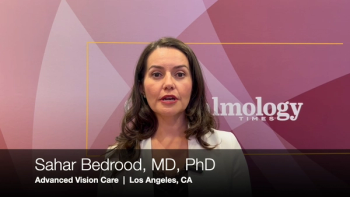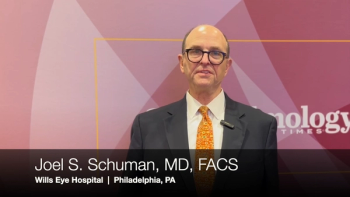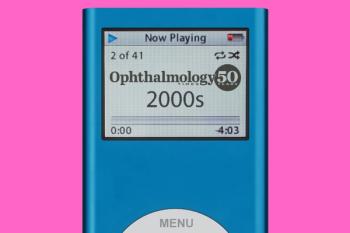
Nitric Oxide and Its Important Role in the Trabecular Meshwork of Glaucoma Patients
Content sponsored by Bausch + Lomb
Steven R. Sarkisian Jr., M.D.
Still a leading cause of preventable blindness, glaucoma is projected to affect almost 80 million people worldwide by the year 2020.1 We know that increased intraocular pressure (IOP) is the only modifiable risk factor for the development of glaucoma, but the disease often goes undetected in some patients due to the presence of normal IOP or lack of symptomology, particularly in the early course of disease. As ophthalmologists, we are tasked with the challenge of identifying patients at risk and initiating treatment to slow disease progression to preserve vision, while incurring as few adverse effects as possible.
Most of our clinical experience in treating glaucoma thus far has been limited to therapies that lower IOP by either increasing aqueous humor outflow through the uveoscleral pathway or by suppressing aqueous humor secretion.2 Therapies have largely ignored the trabecular meshwork, which is the eye's primary outflow pathway that allows the aqueous humor to drain into Schlemm's canal.3 Both the uveoscleral and trabecular meshwork pathways contribute to aqueous humor outflow to different extents, with the trabecular meshwork accounting for 60 percent to 80 percent, and thereby representing a target for innovative treatment options.4-5
In November 2017, the United States Food and Drug Administration approved VYZULTA™ (latanoprostene bunod ophthalmic solution), 0.024%, a novel nitric oxide-releasing agent that works to increase the flow of aqueous humor and lower IOP by targeting both the trabecular meshwork and uveoscleral pathways.6-8 This dual-action agent is metabolized into two moieties: latanoprost acid, which primarily functions in the uveoscleral pathway to increase interstitial spacing between ciliary muscles; and butanediol mononitrate, which releases nitric oxide to relax the trabecular meshwork.9-14 We know that nitric oxide is generated endogenously and acts as a signaling mediator throughout the body. In healthy eyes, nitric oxide is produced by Schlemm's canal. It then diffuses into the trabecular meshwork to activate the sGC-cMP pathway.9-12 This triggers a cascade of events that leads to the inhibition of Rho kinase and calcium signaling, two major causes of trabecular meshwork contraction. Nitric oxide ultimately relaxes the trabecular meshwork to allow for increased aqueous humor outflow.9-14 We have learned from numerous studies that patients with open-angle glaucoma (OAG) present with decreased levels of nitric oxide markers, and a therapy aimed at increasing nitric oxide levels could thus be an important treatment option.15-17
The efficacy and safety of VYZULTA have been substantiated in a number of clinical studies. APOLLO and LUNAR, the pivotal studies for VYZULTA, were designed to evaluate noninferiority of once-daily VYZULTA 0.024% versus timolol 0.5% twice-daily in a total of 774 patients with OAG or ocular hypertension. VYZULTA not only achieved its primary endpoint of noninferiority at all timepoints in both studies, but also demonstrated significantly greater IOP lowering versus timolol 0.5%, with mean IOP reduction between 7.5 to 9.1 mmHg from baseline.18-19 VYZULTA demonstrated superior IOP lowering versus timolol 0.5% at all time points at Month 3.20 Analysis of pooled data from both the APOLLO and LUNAR studies further demonstrated a 32 percent reduction of IOP from baseline three months after initiation of VYZULTA treatment versus 27.6 percent for timolol-treated patients (P<0.001).20 The safety of VYZULTA was also confirmed in these studies. The most common adverse reaction was conjunctival hyperemia at 6 percent and less than 1 percent of patients discontinued therapy due to ocular adverse reactions.6 Please see Important Safety Information below.
The JUPITER study evaluated the long-term safety and efficacy of VYZULTA in Japanese patients (N=130) with a mean baseline IOP of 19.6 mmHg (75 percent of study eyes had baseline IOP between 15-21 mmHg). Treatment with VYZULTA resulted in a reduced mean IOP to 14.4 mmHg, representing a 26.5 percent reduction from baseline at Month 12.21 When compared with Xalatan® (latanoprost) 0.005% in the Phase 2, dose-ranging VOYAGER study (VYZULTA arm: N=83; Xalatan arm: N=82), VYZULTA was significantly more efficacious at lowering IOP at day 28, achieving approximately 35 percent mean reduction of mean IOP from baseline, versus approximately 30 percent for Xalatan (latanoprost) 0.005% (P=0.005).22 Additionally, approximately 68 percent of patients treated with VYZULTA achieved a mean diurnal IOP of ≤18 mmHg compared to 47 percent of patients with Xalatan (latanoprost) 0.005% (P=0.05). In a post hoc analysis, 42 percent of patients achieved greater than 2 mmHg more reduction than Xalatan (latanoprost) 0.005%, which had a mean diurnal IOP reduction of 7.8 mmHg (P=0.005).23
Summary
By addressing the need for innovative treatment options, the approval of VYZULTA has generated enthusiasm from ophthalmologists. Dual-action that harnesses the important role of nitric oxide in maintaining IOP, once-daily dosing, and demonstrated efficacy and safety profiles suggest that VYZULTA could secure a place in the treatment of glaucoma. Thus far, our real-world clinical experience has been aligned with study findings, with numerous patients already benefiting from treatment.
INDICATION
VYZULTA™ (latanoprostene bunod ophthalmic solution), 0.024% is indicated for the reduction of intraocular pressure (IOP) in patients with open-angle glaucoma or ocular hypertension.
IMPORTANT SAFETY INFORMATION
- Increased pigmentation of the iris and periorbital tissue (eyelid) can occur. Iris pigmentation is likely to be permanent
- Gradual changes to eyelashes, including increased length, increased thickness, and number of eyelashes, may occur. These changes are usually reversible upon treatment discontinuation
- Use with caution in patients with a history of intraocular inflammation (iritis/uveitis). VYZULTA should generally not be used in patients with active intraocular inflammation
- Macular edema, including cystoid macular edema, has been reported during treatment with prostaglandin analogs. Use with caution in aphakic patients, in pseudophakic patients with a torn posterior lens capsule, or in patients with known risk factors for macular edema
- There have been reports of bacterial keratitis associated with the use of multiple-dose containers of topical ophthalmic products that were inadvertently contaminated by patients
- Contact lenses should be removed prior to the administration of VYZULTA and may be reinserted 15 minutes after administration
- Most common ocular adverse reactions with incidence ≥2% are conjunctival hyperemia (6%), eye irritation (4%), eye pain (3%), and instillation site pain (2%)
VYZULTA and the V design are trademarks of Bausch & Lomb Incorporated or its affiliates.
Content©2018 Bausch & Lomb Incorporated. All rights reserved. VYZ.0330.USA.18
Dr. Sarkisian serves as a clinical professor of Ophthalmology at the University of Oklahoma, Dean McGee Eye Institute, and is Founder and CEO of Oklahoma Eye Surgeons, PLLC in Oklahoma City. He is one of the foremost ophthalmologists in transforming the treatment of glaucoma and has been active in numerous clinical trials in the field. Dr. Sarkisian is involved in the development of new, innovative glaucoma technology and active in presenting and publishing clinical data in both the U.S. and internationally.
Dr. Sarkisian is a paid advisor and speaker for Bausch + Lomb. This article was sponsored by Bausch + Lomb.
References
1. Quigley HA, Broman AT. The number of people with glaucoma worldwide in 2010 and 2020. Br J Ophthalmol. 2006;90:262-267.
2. Weinreb RN, Aung T, Medeiros FA. The pathophysiology and treatment of glaucoma: a review. JAMA. 2014;311:1901-1911.
3. Goel M, Picciani RG, Lee RK, Bhattacharya SK. Aqueous Humor Dynamics: A Review. Open Ophthalmol J. 2010;4:52-59.
4. Winkler NS, Fautsch MP. Effects of prostaglandin analogues on aqueous humor outflow pathways. J Ocul Pharmacol Ther. 2014;30:102-109.
5. Cavet ME, DeCory HH. The role of nitric oxide in the intraocular pressure lowering efficacy of latanoprostene bunod: review of nonclinical studies. J Ocul Pharmacol Ther. 2018;34:52-60.
6. VYZULTA Prescribing Information. Bausch & Lomb, Incorporated. 2018.
7. Krauss AH, Impagnatiello F, Toris CB, et al. Ocular hypotensive activity of BOL-303259-X, a nitric oxide donating prostaglandin F2α agonist, in preclinical models. Exp Eye Res. 2011;93:250-255.
8. Cavet ME, Vollmer TR, Harrington KL, et al. Regulation of Endothelin-1-Induced Trabecular Meshwork Cell Contractility by Latanoprostene Bunod. Invest Ophthalmol Vis Sci. 2015;56:4108-4116.
9. Cavet ME, Vittitow JL, Impagnatiello F, et al. Nitric oxide (NO): an emerging target for the treatment of glaucoma. Invest Ophthalmol Vis Sci. 2014;55:5005-5015.
11. Schneemann A, Dijkstra BG, van den Berg TJ, et al. Nitric oxide/guanylate cyclase pathways and flow in anterior segment perfusion. Graefes Arch Clin Exp Ophthalmol. 2002;240:936-941.
12. Wiederholt M, Sturm A, Lepple-Wienhues A. Relaxation of trabecular meshwork and ciliary muscle by release of nitric oxide. Invest Ophthalmol Vis Sci. 1994;35:2515-2520.
13. Tamm ER, Braunger BM, Fuchshofer R. Intraocular Pressure and the Mechanisms Involved in Resistance of the Aqueous Humor Flow in the Trabecular Meshwork Outflow Pathways. Int Prog Mol Biol Transl Sci. 2015;134:301-314.
14. Braunger BM, Fuchshofer R, Tamm ER. The aqueous humor outflow pathways in glaucoma: A unifying concept of disease mechanisms and causative treatment. Eur J Pharm Biopharm. 2015;95(Pt B):173-181.
15. Doganay S, Evereklioglu C, Turkoz Y, et al. Decreased nitric oxide production in primary open-angle glaucoma. Eur J Ophthalmol. 2002;12:44-48.
16. Galassi F, Renieri G, Sodi A, et al. Nitric oxide proxies and ocular perfusion pressure in primary open angle glaucoma. Br J Ophthalmol. 2004;88:757-760.
17. Nathanson JA, McKee M. Alterations of ocular nitric oxide synthase in human glaucoma. Invest Ophthalmol Vis Sci. 1995;36:1774-1784.
18. Weinreb RN, Scassellati Sforzolini B, Vittitow J, Liebmann J. Latanoprostene Bunod 0.024% versus Timolol Maleate 0.5% in Subjects with Open-Angle Glaucoma or Ocular Hypertension: The APOLLO Study. Ophthalmology. 2016;123:965-973.
19. Medeiros FA, Martin KR, Peace J, et al. Comparison of Latanoprostene Bunod 0.024% and Timolol Maleate 0.5% in Open-Angle Glaucoma or Ocular Hypertension: The LUNAR Study. Am J Ophthalmol. 2016;168:250-259.
20. Weinreb RN, Liebmann JM, Martin KR, Kaufman PL, Vittitow JL. Latanoprostene Bunod 0.024% in Subjects With Open-angle Glaucoma or Ocular Hypertension: Pooled Phase 3 Study Findings. J Glaucoma. 2018;27:7-15.
21. Kawase K, Vittitow JL, Weinreb RN, et al for the JUPITER Study Group. Long-term Safety and Efficacy of Latanoprostene Bunod 0.024% in Japanese Subjects with Open-Angle Glaucoma or Ocular Hypertension: The JUPITER Study. Adv Ther. 2016;33:1612-1627.
22. Weinreb RN, Ong T, Scassellati Sforzolini B, et al for the VOYAGER study group. A randomised, controlled comparison of latanoprostene bunod and latanoprost 0.005% in the treatment of ocular hypertension and open angle glaucoma: the VOYAGER study. Br J Ophthalmol. 2015;99:738-745.
23. Data on file. Bausch & Lomb Incorporated.
Newsletter
Don’t miss out—get Ophthalmology Times updates on the latest clinical advancements and expert interviews, straight to your inbox.



















































.png)


